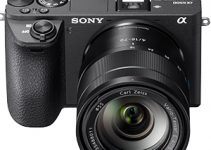There are certain indications that 2018 will become one of the most competitive years for the mirrorless camera market to date. With the A7S III rumors heating up and the recent announcement of the Blackmagic Design Pocket Cinema Camera 4K, who knows what else the big boys might have up their sleeve down the road. Aside from that, of all the products released by different manufacturers thus far, two particular cameras continue to dominate the market and spark interest in the eyes of indie filmmakers.
After Panasonic rolled out the GH5S to compete directly with the arguably the best mirrorless low-light performer – the A7S II, Sony fired back with the A7 III which in certain aspects does seem to outperform their own market leader.
With both cameras having gained significant interest from the filmmaking community, it’s reasonable to ask how do the two units compare. The comprehensive video below produced by Slash Cam pins each camera in several back-to-back comparison shots, particularly testing their autofocus, skin tones, and low-light performance.
The first two tests in the video were meant to test the autofocus capabilities of each camera while tracking a moving subject. Regarding additional settings, continuous autofocus and face detection were enabled whenever possible. Based on the two tests, it’s hard to find any discernible difference in regards to how well the autofocus works in each device when mounted on a tripod.
The battle between the two rivals intensifies in the third test, however, when trying to autofocus using a handheld camera on a constantly moving subject. In this case, the GH5S seemed to lag behind the A7III, especially when going further from the camera. On the other hand, the A7III was able to precisely track and maintain focus on the subject, which is large in part to the camera’s ability to use Phase and Contrast Detection-based autofocus.
When observing the reproduction of skin tones in both cameras, the edges have to go to the GH5S. This applies to both the daylight and mixed light tests. While the differences between the units may be subtle, the skin tones of the GH5S leaned more towards a red, true-color hue. In contrast, the skin tones found on the A7III were more than decent, although appeared a bit tinted towards a magenta color.
Looking at the low light comparison, I guess it’s safe to say that the Sony’s engineering team remains unbeaten when it comes to mastering the craft of designing extremely efficient in low light back-illuminated camera sensors. While noise begins to appear at ISO 3,200, the overall image quality in terms of sharpness and color is maintained, even at up to ISO 10,000, which seems to be the recommended maximum value if you’re planning to shoot with the camera in such conditions.
Meanwhile, if you need to raise the ISO higher, try not to go beyond ISO 20,000 since some color shifting, noise, and loss of image detail may occur.
On certain occasions, when surpassing the recommended ISO 20,000 limit, you’ll be surprised to see a stunning amount of image detail preserved, as seen in the buildings in the back of the shot below. These amazing capabilities make the A7 III a real no-brainer for documentary shooters as the camera allows working in tremendously dimmed light conditions with minimal loss in image quality and detail alongside relatively low noise levels.
As for the GH5S, it’s clear that the camera can also operate in low-light conditions, but it can’t outperform the Sony’s competitor. At around 3,200 ISO, there’s more noise present than the A7III at the same ISO setting. Going even higher with the ISO value (above 10,000), you’ll notice more noise and a more drastic color shift than in the A7III. While the footage may be usable, more work may have to be done in post to salvage the shot if it’s absolutely necessary.
What’s your favorite pick based on the above results? Drop a few lines down in the comments.
[source: slashcam]
Order Links:
Sony Alpha a7 III Mirrorless Digital Camera (Body Only) (B&H, Amazon)
Panasonic Lumix DC-GH5S Mirrorless Micro Four Thirds Digital Camera (B&H, Amazon)
Disclaimer: As an Amazon Associate partner and participant in B&H and Adorama Affiliate programmes, we earn a small comission from each purchase made through the affiliate links listed above at no additional cost to you.


